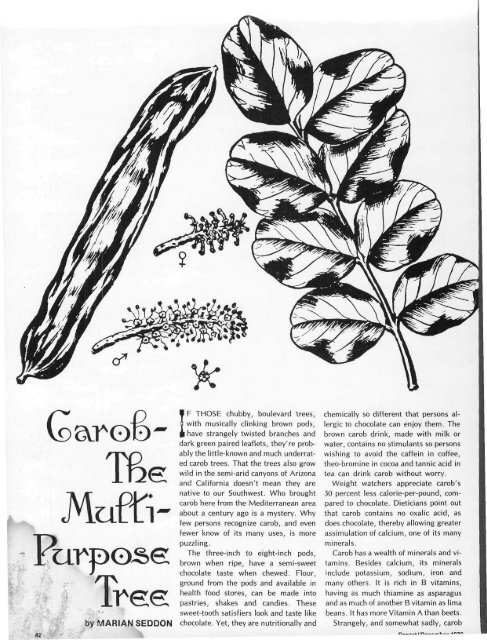1 - Desert Magazine of the Southwest
1 - Desert Magazine of the Southwest
1 - Desert Magazine of the Southwest
Create successful ePaper yourself
Turn your PDF publications into a flip-book with our unique Google optimized e-Paper software.
G&roS-<br />
Trk<br />
Muffi-<br />
Purpose<br />
Tree<br />
42<br />
by MARIAN SEDDON<br />
F THOSE chubby, boulevard trees,<br />
with musically clinking brown pods,<br />
! have strangely twisted branches and<br />
dark green paired leaflets, <strong>the</strong>y're probably<br />
<strong>the</strong> little-known and much underrated<br />
carob trees. That <strong>the</strong> trees also grow<br />
wild in <strong>the</strong> semi-arid canyons <strong>of</strong> Arizona<br />
and California doesn't mean <strong>the</strong>y are<br />
native to our <strong>Southwest</strong>. Who brought<br />
carob here from <strong>the</strong> Mediterranean area<br />
about a century ago is a mystery. Why<br />
few persons recognize carob, and even<br />
fewer know <strong>of</strong> its many uses, is more<br />
puzzling.<br />
The three-inch to eight-inch pods,<br />
brown when ripe, have a semi-sweet<br />
chocolate taste when chewed. Flour,<br />
ground from <strong>the</strong> pods and available in<br />
health food stores, can be made into<br />
pastries, shakes and candies. These<br />
sweet-tooth satisfiers look and taste like<br />
chocolate. Yet, <strong>the</strong>y are nutritionally and<br />
chemically so different that persons allergic<br />
to chocolate can enjoy <strong>the</strong>m. The<br />
brown carob drink, made with milk or<br />
water, contains no stimulants so persons<br />
wishing to avoid <strong>the</strong> caffein in c<strong>of</strong>fee,<br />
<strong>the</strong>o-bromine in cocoa and tannic acid in<br />
tea can drink carob without worry.<br />
Weight watchers appreciate carob's<br />
30 percent less calorie-per-pound, compared<br />
to chocolate. Dieticians point out<br />
that carob contains no oxalic acid, as<br />
does chocolate, <strong>the</strong>reby allowing greater<br />
assimulation <strong>of</strong> calcium, one <strong>of</strong> its many<br />
minerals.<br />
Carob has a wealth <strong>of</strong> minerals and vitamins.<br />
Besides calcium, its minerals<br />
include potassium, sodium, iron and<br />
many o<strong>the</strong>rs. It is rich in B vitamins,<br />
having as much thiamine as asparagus<br />
and as much <strong>of</strong> ano<strong>the</strong>r B vitamin as lima<br />
beans. It has more Vitamin A than beets.<br />
Strangely, and somewhat sadly, carob

















